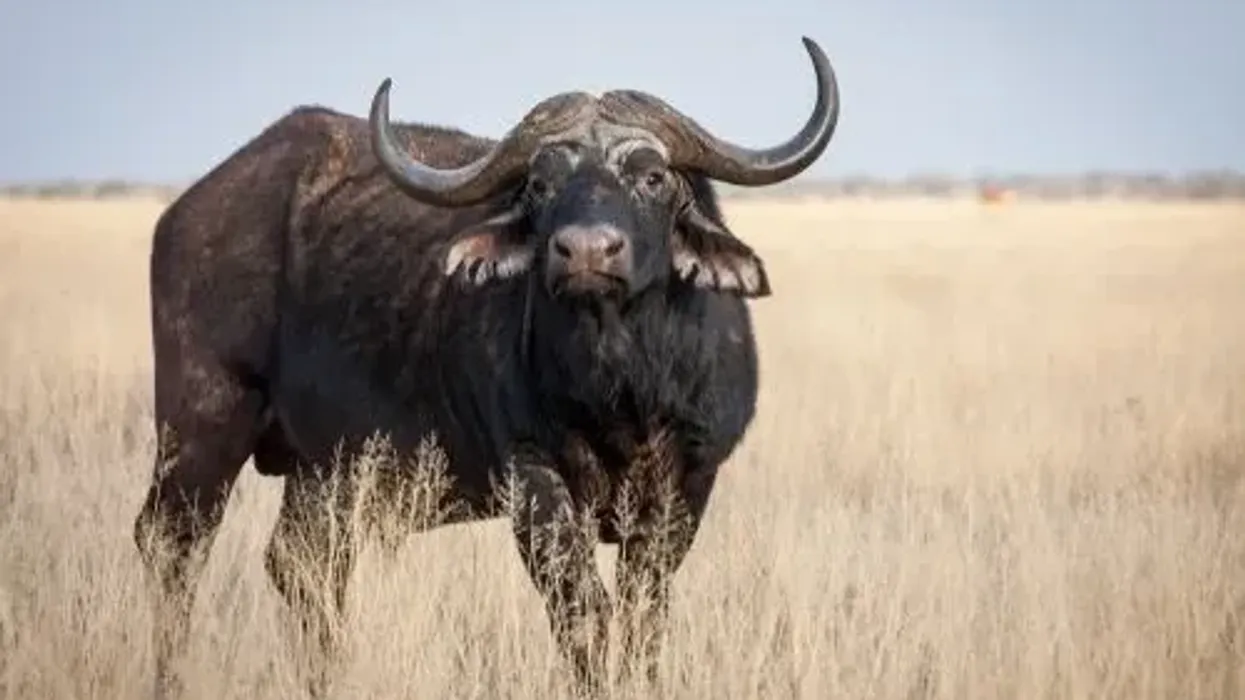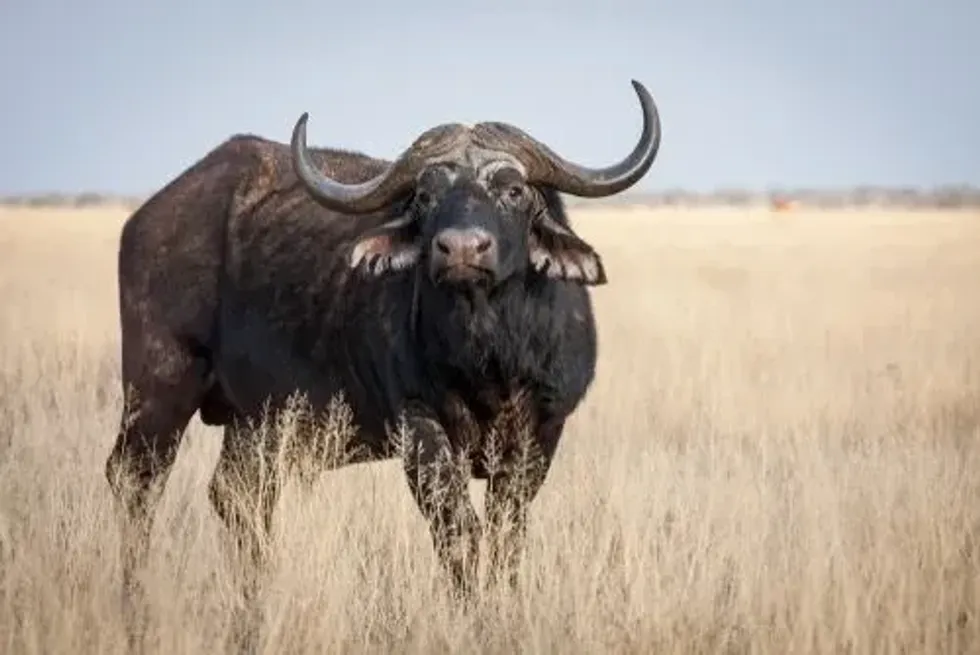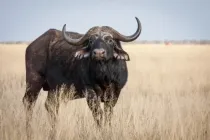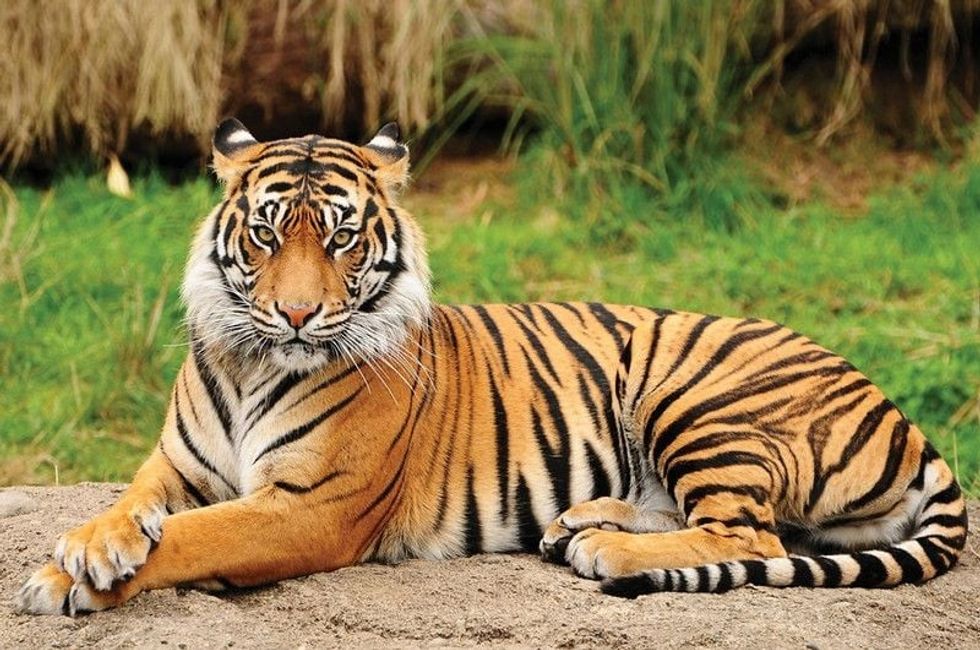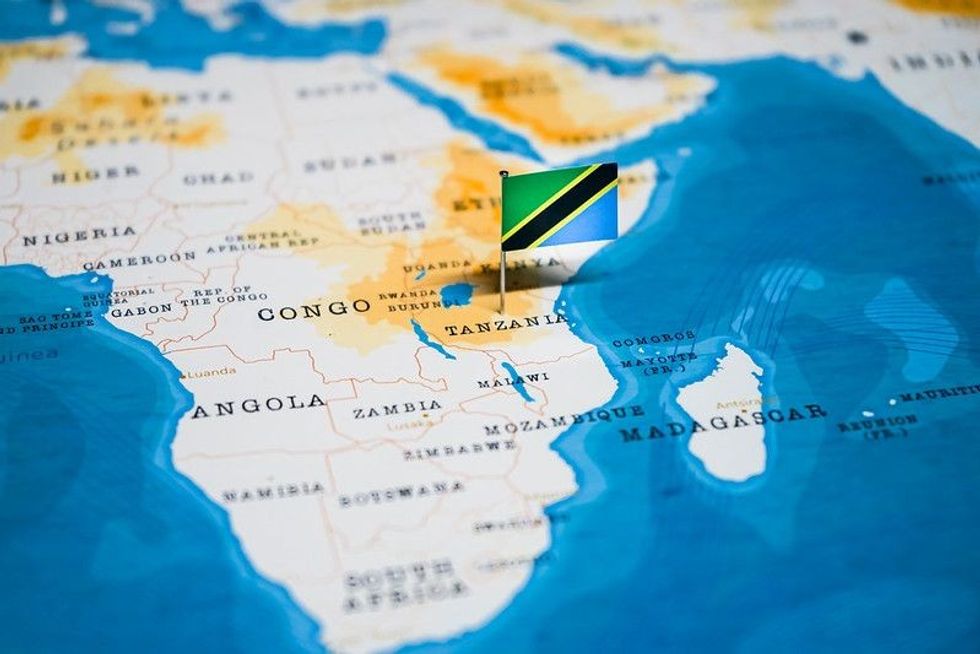The Cape or African buffalo is a large bovine that is found in sub-Saharan regions of Africa. They are the smallest subspecies of the African buffalo. Cape buffalo are known to be one of the fiercest animals found in the African wildlife as they are massively built with a robust body and horns that are outright deadly in nature!
Cape buffalo are grazing animals and large parts of their diet are made up of grass and other plants.
They are docile in nature but when threatened will get aggressive and attack any predator that will try to harm them. They are herd animals and live in a herd that can range from 1,000-5,000 depending on the region they live in and how close a water source is.
Their special feature is their large horn that has fused bases, which forms a shield of bone at the top of their head, and can have a span of almost 1m!
If you liked these true facts about Cape buffalo, then you'll surely like these facts about the Masai giraffe and plains zebra too!
Cape Buffalo Interesting Facts
What type of animal is a Cape buffalo?
The African buffalo (Syncerus caffer), sometimes known as the Cape buffalo, is a huge sub-Saharan African bovine. The Cape buffalo is one of the four subspecies of African buffalo and is the most common one. They're distinguished by size, coloring, and horn shape. It is often mistaken for the smaller Water buffalo or the Forest Buffalo.
Cape Buffalo horns have fused bases, which form a continuous bone shield on top of their head which is referred to as a 'boss'. Cape buffalos are considered to be one of the most dangerous animals on the African continent due to their aggressiveness and raw strength! They are estimated to trample and kill over 200 people every year!
What class of animal does a Cape buffalo belong to?
The Cape buffalo, the scientific name Syncerus caffer, belongs to the mammal class of animals. The presence of mammary glands to feed their young one, along with three ear bones, fur or hair, and the neocortex (region of the brain), are the defining factors of mammals.
How many Cape buffaloes are there in the world?
The Cape Buffalo was once listed Least Concern by the IUCN Red List and had an estimated global population of 900,000 individuals, of which more than three-quarters were in protected areas.
However, in 2019, the recorded number of cape buffalo went down as low as 569,000-573,000 individuals in the wild and is now listed as Near Threatened, according to the IUCN Red List.
A healthy population in all parts of Africa is being maintained by national parks that keep a check on poachers and hunting zones in Cape Buffalo territories.
Where does a Cape buffalo live?
Cape buffaloes thrive in virtually all types of sub-Saharan regions of Africa. From dry savannas to swamps that are almost drowned during the rainy season, and from lowland floodplains to mixed forests and glades. Cape buffaloes can thrive anywhere.
What is a Cape buffalo's habitat?
The Cape Buffalo is a grazer, feeding on grasses, herbs, swamp vegetation and occasionally browsing on leaves. They prefer a habitat that has dense covers such as reeds or thickets and has a water source close by as these animals require a large amount of water daily to function.
Cape Buffaloes do not stay in depleted areas for long. The African Buffalo has a symbiotic relationship with birds such as cattle egrets, who clean their skin of biting and sucking insects!
Apart from humans, the Cape Buffalo is hunted by big game hunters like lions and crocodiles that typically attack solitary buffaloes and young calves.
Who do Cape buffaloes live with?
The Cape Buffalo is a herd animal and has a stable composition, which changes only in cases of deaths and births. On average, a Cape buffalo herd can comprise 350 members, but it may grow as large as 5,000 strong!
Large herds tend to break up during seasons with dry weather and regroup in the rainy season. Going their separate ways in the dry season helps in grazing load when the grass is in short supply.
Each group or herd has a particular and fair range that does not overlap with the adjacent herd which helps in lowering the conflict among particular groups as these groups tend to aim at river banks. The basic social unit is that of female adults, their suckling calf from the previous season's breeding.
They stick together unless there's a death.
The movement of the African buffalo herd depends on a 'voting' procedure when most of the time takes them in the direction of the greatest amount of grass in the area. Mature bulls usually tend to form a small group of older experienced members of up to four or five bulls who are referred to collectively as 'gangs'.
How long does a Cape buffalo live?
This subspecies of buffaloes have a lifespan of roughly 20-23 years in the wild. The male is ranked by its fighting capabilities by having clashes to determine the alpha male in the herds. In captivity, however, they have a lifespan that can be as long as 29 years.
How do they reproduce?
The males (bull) and females (cows) have different ages for sexual maturity, the females can reach sexual maturity at about three years of age, and bulls at six years, but females have their first calves at five years old.
Cows have a gestation period of 11 months and the mating process usually takes place during the late summer. The calves are carried for 11 months and then born in the midst of herds usually during the rains.
The calf is later licked clean and suckles upon the mother and after this process is over, the calves join and become part of the grazing herds.
What is their conservation status?
The IUCN Red List categorizes the African Buffalo as a species that is Near Threatened. Due to unchecked poaching, along with natural factors like droughts, illnesses, and other issues, the population of African Buffalo has dwindled in the years that followed.
Once, estimated at around 900,000 individuals in the wild, these majestic and dangerous wild creatures are now estimated to be around 569,000-573,000 in the wild.
Strict conservation efforts by the various national parks and forest rangers have helped keep their population from decreasing at a rapid rate by keeping a check on illegal poaching and natural deaths in cases of droughts and diseases.
The African buffalo face conservation challenges even with protection efforts because of their conflicts with humans mainly because of their aggression and size. In certain parts of Africa, they are known to tear through crops and spread diseases to livestock like bovine tuberculosis other harmful diseases.
Cape Buffalo Fun Facts
What do Cape buffaloes look like?
The Cape buffalo, one of the four distinct subspecies alongside, the forest buffalo, West African savanna buffalo, and the Central African savanna buffalo, are the most commonly found species in the African wildlife. The African Cape buffalo hide is one of the thickest hides of these species of cattle, measuring up to two inches in thickness!
They are large beasts with almost dark brown to black hide and drooping, fringed ears.
The cows are smaller than the bulls as these animals are sexually dimorphic in nature. Both genders have large curved horns that help in protection against predators.
The African Cape Buffalo is known to be one of the most dangerous and meanest beasts in the African wildlife. Cape buffalo attacks are common in nature, as it's their natural reaction to being shot or hurt and an estimate of 200 people die per year to African buffalo attacks.

How cute are they?
Calves, yes. Adults, not so much! The adults are outright ferocious to look at, but are docile in nature and will only get aggressive if they feel threatened by predators.
How do they communicate?
The African buffalo (Syncerus caffer) is said to be able to communicate with each other through low-pitched sounds that they space three to six seconds apart which is used to guide herds to keep on the move.
Grittier variations of this low pitch sound serve as a signal for herds to change direction. Researchers have found that African buffalo make a 'moo' sound when they approach water sources as this sound might be an expression of happiness, pleasure, contentment, or anticipation.
These animals also make loud grunts or rumbling growls to signal aggression towards a fellow buffalo and are known to make a long 'waaa' call when the herds are threatened by predators such as lions or crocodiles.
How big is a Cape buffalo?
Cape buffaloes are robust in nature and can grow from 3.3-5.6 ft (1-1.7 m) in shoulder height, and their head to body length ranges from 5.6-11.2 ft (1.7-3.4 m),with the tails adding an extra 27.6-43.3 in (70-110 cm).
How fast can a Cape buffalo run?
These animals are powerful, aggressive, and fast! They are known to be able to run at speeds of up to 35 mph (56.3 kph) to escape predators.
How much does a Cape buffalo weigh?
Cape buffalo are massive in weight and can weigh from 937-1918 lb (425-870 kg).
What are their male and female names of the species?
Much like the much common cattle species, male buffaloes are called bulls, and females are called cows.
What would you call a baby Cape buffalo?
Baby Cape buffaloes are called calves. Cows give birth to calves after a gestation period of 11 months and are born amidst the herd and thereafter cleaned, fed, and start walking and soon become part of the herd.
What do they eat?
The African buffalo (Syncerus caffer) has a diet that comprises a lot of grass. When grass isn't available, they chew their way through leaves, plants, and sedges. Like other common cattle, they chew cud to extract nutrients.
Are they dangerous?
Yes! They are so dangerous that they are called 'the Black Death'! They are said to have killed more big game hunters than any other animals in the African wildlife.
They rank in the top five of the most dangerous animals to hunt. They are most aggressive when wounded, or a calf from the herd has been attacked by predators. Males and females will chase predators down when calves are hurt.
An angry Cape buffalo charges in with its massive horns and attack preys after they stalk it and are done waiting for the perfect opportunity to attack.
They also portray mobbing behavior when fighting off predators and seeing a mob of buffaloes running at you at speeds of 35 mph (56.3 kph) is certainly a scary situation to be in!
Would they make a good pet?
Not at all! Unlike the Asian Water buffalo, the African buffalo has never been domesticated and hence there are no records of how these animals react to being domesticated.
Did you know...
A Cape buffalo is able to tip over cars with its freakish strength!
Cape buffalo calves are known to have a spot on their heads called 'buttons' where the horns will grow as they mature.
These animals are excellent swimmers and are known to often cross large rivers in search of good grazing lands.
If you were to put have a Cape buffalo vs elephant fight based on just intelligence and memory, it would be a draw! Cape buffaloes much like the elephant have a great memory and are able to attack people or animals that have harmed them years after the event.
The Cape Buffalo is adept at revenge and will kill lions that have attacked them, sometimes even targeting lion cubs and killing them as a preventative measure.
Due to their good population in the wild, it is legal to hunt Cape buffalo. Cape buffalo hunting costs a trophy fee of $10,000 ! But due to the aggressive nature of the buffalo, dozens of hunters get killed in a cape buffalo hunt effort. It is, however, illegal to see the meat of a hunter buffalo.
Cape buffalo are also known as 'dagga boy'. A mixture of sand, water, and cement used in the rural buildings found in Africa is called Dagga. The Cape buffalo likes to bask in the mud to cool down and in turn, get rid of ticks. The dried skin looks like dagga, hence the nickname.
The Cape buffalo is notoriously dangerous when it feels cornered or is injured. Many big game hunters taking part in cape buffalo hunts have stories of buffaloes goring and killing the shooter that injured them.
The African or Cape buffalo is often confused with the Asian water buffalo, although neither share many of each other's characteristics and are a separate species.
The World Record Cape Buffalo on file is a cow with a horn spread of 62 in (157.5 cm).
Can a Cape buffalo kill a lion?
If you had to run a simulation of a Cape buffalo vs. lion, then the buffalo would come out stronger as Cape buffalo rarely travel alone, and hence in cases of lion attacks, they fight them off. The strong muscular build of a buffalo means that it would take at least two to three adult lions to kill one.
In rare cases, the Cape buffalo can mortally wound a lion and kill it in extreme cases.
How strong are a Cape buffalo's senses?
The African buffaloes have an excellent sense of smell! Although they have poor eyesight and hearing, they have an acute sense of smell and often use it to find food or detect predators. They also use smell to communicate socially by making cow-like bellows to maintain contact with their herd while traveling.
Here at Kidadl, we have carefully created lots of interesting family-friendly animal facts for everyone to discover! Learn more about some other mammals including wildebeest, or water buffalo.
You can even occupy yourself at home by drawing one on our Cape buffalo coloring pages.

